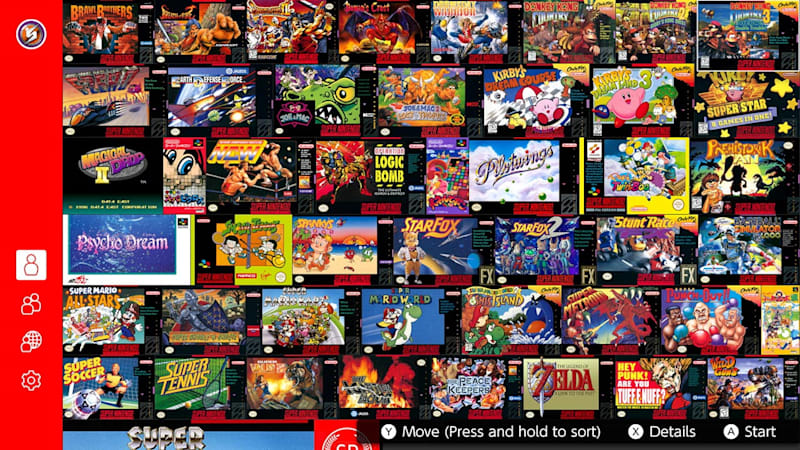Topic Super Nintendo Games: Embark on a nostalgic journey with "Super Nintendo Games", where classic gaming meets timeless charm. Explore the iconic world that revolutionized the gaming industry and continues to captivate players worldwide.
Table of Content
- History and Evolution of Nintendo
- Iconic Super Nintendo Games
- Super Nintendo"s Technological Advances
- Impact of Super Nintendo on Gaming Culture
- YOUTUBE: Top 300 Super Nintendo games: 1991-1997, in chronological order
- Notable Game Developers for Super Nintendo
- Comparative Analysis: Super Nintendo vs. Modern Consoles
- Legacy and Revival of Classic Super Nintendo Games
- Nintendo"s Future in Gaming
History and Evolution of Nintendo
Nintendo, a name synonymous with gaming innovation, embarked on its journey as a playing card company in 1889. The company"s foray into the world of toys in the 1960s marked the beginning of its transformation. Gunpei Yokoi"s inventions, like the Ultra Hand, became early toy blockbusters, leading Nintendo to delve into electronic toys.
In the 1970s, Nintendo ventured into the burgeoning video game market. Its partnership with Magnavox to produce optoelectronic guns for the Odyssey, the first home console in the United States, was Nintendo"s initial step into this arena. Following this, Nintendo shifted focus to family-friendly arcades with the Laser Clay Shooting System and later entered the home console market with the Color TV-Game 6 and 15, developed in collaboration with Mitsubishi Electric.
The 1980s saw Nintendo revolutionize the arcade game sector with titles like "Donkey Kong", designed by Shigeru Miyamoto. This success laid the groundwork for their entry into the home console market. The release of the Nintendo Entertainment System (NES) in 1985 marked a significant turn in the gaming industry, reviving it from the 1980s crash.
Entering the 16-bit era, Nintendo unveiled the Super Nintendo Entertainment System (SNES) in 1990. This console introduced advanced graphics and sound capabilities, setting new standards in the industry. The SNES, facing fierce competition from Sega"s Genesis, played a crucial role in the legendary "console wars" of the early 90s. Its innovative controller design, featuring the introduction of the “X” and “Y” buttons, and the graphical capabilities like Mode 7, which created a pseudo-3D perspective, were pivotal in its success.
The SNES library was a treasure trove of gaming excellence, with titles like "Super Mario World", "The Legend of Zelda: A Link to the Past", and "Super Metroid" setting benchmarks in their respective genres. The console"s global success contributed to Nintendo"s lasting legacy in the gaming world, influencing subsequent generations of consoles and games.
As Nintendo continued to innovate, it introduced the Nintendo 64, which marked the transition to 3D gaming, followed by the GameCube, Wii, Wii U, and the Nintendo Switch, each bringing unique innovations and expanding Nintendo"s influence in the gaming world.
In conclusion, Nintendo"s journey from a traditional playing card company to a leading innovator in the gaming industry is a story of constant evolution, creativity, and an enduring impact on gaming culture and technology.

READ MORE:
Iconic Super Nintendo Games
The Super Nintendo Entertainment System (SNES) is renowned for its exceptional game library, featuring a mix of genre-defining classics and innovative titles. Here is a look at some of the most iconic games that defined the SNES experience:
- Street Fighter II" Turbo: Hyper Fighting: A definitive entry in Capcom"s premier fighting franchise, known for its robust gameplay and being a technical marvel on the SNES.
- U.N. Squadron: A challenging shooter with great music, varied levels, and exciting action, making it a memorable experience on the SNES.
- Shadowrun: Known for its atmospheric music and gripping narrative, this game combines challenging gameplay with an engaging story.
- Soul Blazer: An action-RPG that stands out for its play control system and unique gameplay elements.
- The Adventures of Batman & Robin: Based on the popular Batman cartoon, this game is notable for its level design and authenticity to the source material.
- Teenage Mutant Ninja Turtles: Turtles in Time: A classic beat "em up game, offering a variety of levels and gameplay improvements over its arcade version.
- Harvest Moon: A pioneering life simulator that introduced players to the world of farming and community building.
- Super Mario All-Stars: A collection of the first three Super Mario Bros. games with updated graphics and sound, offering a definitive way to experience these classics.
- F-Zero: Known for pioneering pseudo-3D racing and its fast-paced, challenging gameplay.
- Contra III: The Alien Wars: A sequel that raised the bar with its intense action and tough-but-fair difficulty.
- Secret of Mana: An action RPG celebrated for its graphics, soundtrack, and unique three-player co-op gameplay.
- Super Mario Kart: The game that started the Mario Kart franchise, known for its fun racing and battle modes.
- ActRaiser: A unique combination of platforming and city-building gameplay, set against a backdrop of Judeo-Christian mythology.
These games not only define the SNES"s legacy but also highlight the system"s diverse and innovative library that catered to players of all genres, setting a high standard for future gaming consoles.
Super Nintendo"s Technological Advances
The Super Nintendo Entertainment System (SNES), a 16-bit home video game console developed by Nintendo, marked a significant leap in gaming technology when it was released in the early 1990s. It succeeded the Nintendo Entertainment System (NES) and was Nintendo"s response to the emerging competition in the gaming market, notably from Sega"s Genesis console.
One of the SNES"s defining features was its advanced graphics and sound capabilities, which were a substantial improvement over its predecessor, the NES. The SNES was designed to support various enhancement chips integrated into game cartridges, allowing for more sophisticated gaming experiences.
- Graphics: The SNES implemented advanced graphic capabilities, including two separate PPU chips for rendering graphics and providing effects like window, mosaic, and fades. These chips enabled the creation of rich visual experiences with a standard output resolution of 256 x 224 pixels.
- Sound: The console boasted a custom Sony audio chip, allowing for varied and immersive soundtracks in games. This was a significant upgrade from the NES and was a standout feature against its competitors.
- Memory: It featured 128 KB of SRAM, a dramatic increase from the 2 KB of RAM in the NES, allowing for more complex games with detailed environments and sophisticated gameplay.
- Specialized Components: The SNES"s architecture was designed around a relatively slow CPU, surrounded by powerful components that enhanced gaming experiences. This required developers to utilize these components creatively to produce quality games.
- Super FX Chip: Perhaps the most notable innovation was the introduction of the Super FX chip, developed in collaboration with Argonaut Software. This chip enabled polygonal 3D gameplay, a groundbreaking feature at the time, used in games like Star Fox.
- Satellaview: In Japan, the SNES had a satellite modem peripheral called the Satellaview. This allowed players to download games and other content, representing an early form of online gaming and downloadable content.
- Controller Design: The ergonomic design of the SNES controller, with its distinctive shoulder buttons, set a new standard for game controllers and influenced many future designs.
Despite intense competition and a slower CPU compared to available options at the time, the SNES"s combination of innovative graphics, sound, and special chips allowed it to stand out in the gaming industry. It remained popular well into the 32-bit era and continues to be a beloved console among retro gamers and collectors.
Impact of Super Nintendo on Gaming Culture
The Super Nintendo Entertainment System (SNES) significantly influenced gaming culture, introducing groundbreaking games and gameplay experiences. The SNES"s release in 1990 brought critical acclaim and commercial success, captivating players with its 16-bit graphics and immersive sound. With over 700 game titles, including iconic franchises like Super Mario, Donkey Kong, and The Legend of Zelda, the SNES set a new standard in gaming and played a pivotal role in defining the gaming landscape of the 1990s.
1. Technological Innovations and Game Library
- The SNES introduced Mode 7 graphics, enabling dynamic backgrounds and immersive gameplay experiences in titles like F-Zero and Super Mario Kart.
- Its extensive game library featured a mix of genres, catering to a broad audience and including influential RPGs like Final Fantasy and Chrono Trigger.
- The console"s success was bolstered by exclusive titles from Japanese developers, who found a strong partner in Nintendo.
2. Cultural Significance
- The SNES redefined gaming, inspiring future consoles and games with its innovative features.
- Its cultural impact extended beyond mere entertainment, with games fostering social connections, improving cognitive skills, and contributing to the economy.
- Gaming conventions and events, such as E3 and PAX, emerged, celebrating the passion for gaming that consoles like the SNES helped ignite.
3. Redefining "Geek" Culture
The mainstream success of video games, partly driven by the SNES, shifted the perception of "geek" culture. Video games provided a platform for social interaction and skill development, changing how society viewed technology enthusiasts and contributing to the acceptance of geek aesthetics in popular media.
4. Influence on Media and Art
- Video games became a form of artistic expression, with the SNES playing a role in blurring the lines between traditional and digital art.
- The impact of gaming on popular media led to successful game-to-film adaptations and inspired content across various platforms, including YouTube and Twitch.
5. The Legacy of SNES
The SNES remains a beloved console, symbolizing an era of innovation and the joy of play. Its impact on gaming culture and technology continues to resonate, influencing contemporary games and consoles. For many, the SNES represents a golden age of gaming, evoking nostalgia and admiration for its contribution to the gaming industry.
In conclusion, the Super Nintendo Entertainment System"s impact on gaming culture was profound and multifaceted. It not only pushed the boundaries of what was possible in video games but also played a significant role in shaping the broader cultural landscape. The SNES"s legacy is evident in the continued popularity of its games, the enduring affection of gamers, and its influence on modern gaming culture.
Top 300 Super Nintendo games: 1991-1997, in chronological order
Discover the fascinating history of events and stories as we bring them to you in chronological order. Unlock the hidden secrets of the past and gain a deep understanding of how everything unfolded. Join us on this captivating journey through time and witness the incredible sequence of events that shaped the world we know today!
Top 300 Super Nintendo games: 1991-1997, in chronological order
Discover the fascinating history of events and stories as we bring them to you in chronological order. Unlock the hidden secrets of the past and gain a deep understanding of how everything unfolded. Join us on this captivating journey through time and witness the incredible sequence of events that shaped the world we know today!
Notable Game Developers for Super Nintendo
The Super Nintendo Entertainment System (SNES) was home to a plethora of remarkable game developers who contributed significantly to its success. These developers were known for their creativity, innovation, and the memorable gaming experiences they provided.
Key Developers and Their Contributions
- Nintendo: As the creator of the SNES, Nintendo led the way with iconic franchises such as Super Mario, The Legend of Zelda, and Pokémon.
- Capcom: Known for the Mega Man X series and Street Fighter games, Capcom was a major contributor to the SNES"s library with its engaging and diverse titles.
- Konami: This developer was responsible for classics like The Adventures of Batman & Robin, offering unique experiences in various genres.
- Square Enix (formerly Squaresoft): A pivotal player in the realm of RPGs, they produced legendary titles such as Final Fantasy and Chrono Trigger.
- Rare: With its groundbreaking Donkey Kong Country series, Rare showcased the SNES"s graphical capabilities and creative potential.
- Beam Software: Known for Super Smash T.V., Beam Software utilized the SNES"s unique controller layout to great effect.
- Koei: Notable for Gemfire, Koei added depth to the SNES"s catalog with its tactical gameplay.
- Other notable developers: Enix (Soul Blazer), Data East (Shadowrun), Hudson Soft (Hagane: The Final Conflict), and many others contributed to the diverse and rich tapestry of SNES gaming.
These developers, among others, were instrumental in shaping the SNES"s legacy. They pushed the boundaries of 16-bit gaming and created experiences that still resonate with gamers today.
Their contributions extend beyond the games themselves, influencing the course of video game development and the broader gaming culture. The SNES era, thanks to these developers, is fondly remembered as a golden age of creativity and innovation in gaming.

Comparative Analysis: Super Nintendo vs. Modern Consoles
The gaming industry has evolved dramatically from the era of the Super Nintendo Entertainment System (SNES) to the modern consoles of today. This analysis explores the differences and similarities between the SNES and contemporary gaming systems, examining various aspects such as graphics capabilities, game libraries, multiplayer support, controllers, console design, portability, game prices, repairability, and online services.
Graphics Capabilities
- The SNES used pixelated 2D sprites with limited animation and colors, while modern consoles boast high-resolution 3D models with advanced physics and shading.
- Retro consoles like the SNES had static bitmap backgrounds and lower resolution output, in contrast to the fully 3D environments and 4K display support of modern systems.
Game Library
- Both eras offer extensive libraries, with the SNES known for its iconic franchises and self-contained games, and modern consoles featuring backwards compatibility, sequels, remakes, and frequent DLC.
Multiplayer Support
- SNES excelled in local multiplayer with 2-4 players supported in most games, while modern consoles focus heavily on online multiplayer, allowing for larger player counts and social features.
Controllers
- SNES controllers were simpler with basic directional pads and fewer buttons, whereas modern controllers are more complex with analog sticks, triggers, and ergonomic designs.
Console Design
- The SNES featured distinctive and memorable designs, in contrast to the sleek, minimalistic designs of modern consoles that blend into entertainment setups.
Portability
- While the SNES itself wasn"t portable, it inspired the development of portable consoles, a concept that has been partially revived in modern times by consoles like the Nintendo Switch.
Game Prices
- Prices for SNES games can vary significantly due to collectibility, whereas modern games typically see a steady decrease in price over time.
Repairability
- Retro consoles like the SNES are generally easier to repair and modify compared to the more integrated and complex modern systems.
Online Services
- Modern consoles have embraced online services, offering multiplayer access, digital downloads, and entertainment apps, features that were not present in the SNES era.
In conclusion, while modern consoles offer advanced technology and online connectivity, the SNES remains celebrated for its simpler, more direct gaming experience, iconic games, and memorable design. Both retro and modern consoles have their unique appeals and have significantly contributed to the evolution of the gaming industry.
Legacy and Revival of Classic Super Nintendo Games
The Super Nintendo Entertainment System (SNES), a hallmark of 90s gaming, continues to hold a special place in the hearts of gamers. Its legacy is evident in the ongoing popularity and revival of its classic games. Advances in modern technology have made these beloved titles more accessible than ever, allowing a new generation of gamers to experience the magic of the SNES era.
Revival on Modern Platforms
- Many classic SNES titles have found new life through Nintendo"s Switch Online service. Gamers can now enjoy iconic games like Super Mario World, The Legend of Zelda: A Link to the Past, and Super Metroid on their modern devices.
- Updates to the service continue to add more titles, including less mainstream but fondly remembered games such as Joe & Mac 2: Lost in the Tropics, Spanky"s Quest, and Super Baseball Simulator 1.000.
Impact of Super Nintendo World
- The influence of the SNES extends beyond gaming, with the creation of Super Nintendo World at Universal Studios. This theme park brings to life the worlds of Mario, Donkey Kong, and Zelda, offering an immersive experience for fans.
- Shigeru Miyamoto, creator of many iconic Nintendo franchises, played a significant role in designing the park"s attractions, further cementing the cultural impact of these classic games.
Cultural Resonance
- The SNES and its games remain a significant part of gaming history, with a lasting impact on game design and pop culture. Titles like Street Fighter II and Soul Blazer continue to be celebrated for their innovative gameplay and enduring appeal.
- The console"s legacy is also reflected in the continued demand for its games and the high regard in which they are held by the gaming community.
In conclusion, the legacy of the Super Nintendo and its classic games endures through their revival on modern platforms, the creation of themed experiences, and their lasting cultural impact. The SNES era, marked by innovation and creativity, continues to be celebrated and enjoyed by both nostalgic fans and new players alike.

READ MORE:
Nintendo"s Future in Gaming
Nintendo"s journey into the future of gaming looks bright and innovative, with a blend of nostalgia and cutting-edge technology. The anticipation for the "Switch 2," a next-gen console, is high among gaming communities. Rumors and predictions suggest its release might happen in late 2024, marking a significant step in Nintendo"s hardware evolution.
Enthusiasts are excited about the potential for more GameCube remakes and remasters, such as classics like Wind Waker, Twilight Princess, and F-Zero GX. The desire for new 3D Mario games with advanced graphics and gameplay is palpable, along with hopes for innovative RPGs featuring diverse Nintendo characters.
- Next-Gen Console: The "Switch 2" is expected to push the boundaries of Nintendo"s hardware capabilities, possibly featuring enhanced graphics and new gameplay mechanics.
- Game Remakes: Remakes and remasters of beloved GameCube titles could bring a wave of nostalgia, combined with modern gaming elements.
- New Game Titles: A mix of new titles and sequels to iconic games like Metroid Prime and Mario are highly anticipated, potentially showcasing the capabilities of the new hardware.
- Technological Advances: Nintendo might integrate more advanced technology in game delivery, such as streaming options, broadening the accessibility and reach of their games.
- Backward Compatibility: There"s speculation about the backward compatibility of the new console with existing Switch games, which would be a strategic move considering Nintendo"s extensive game library.
With a history of revolutionizing the gaming market, Nintendo"s future endeavors are likely to emphasize both innovation and reverence for its rich gaming heritage. The blend of new technology with beloved classics positions Nintendo to continue its legacy as a pioneer in the gaming industry.
Rediscover the magic of Super Nintendo Games, where nostalgia meets innovation in a timeless gaming adventure. Join us in celebrating a legacy that continues to captivate and inspire gamers across generations.



/cdn.vox-cdn.com/uploads/chorus_image/image/71354547/TFS___Vikings_vs_Packers___20220911.0.jpeg)











